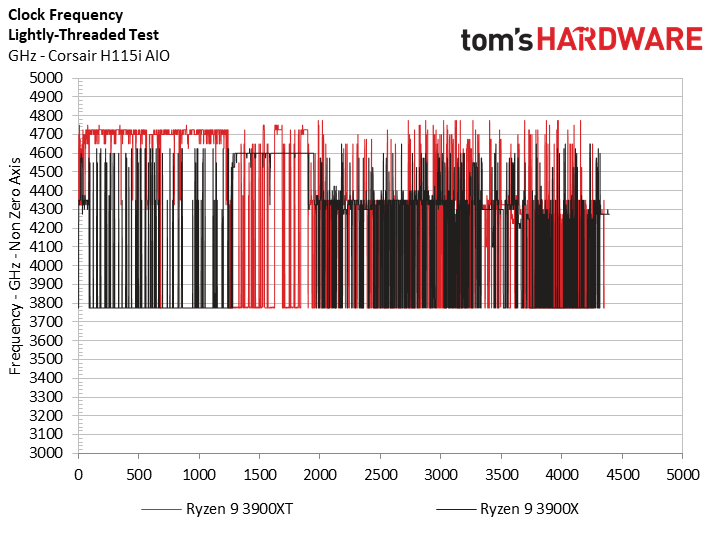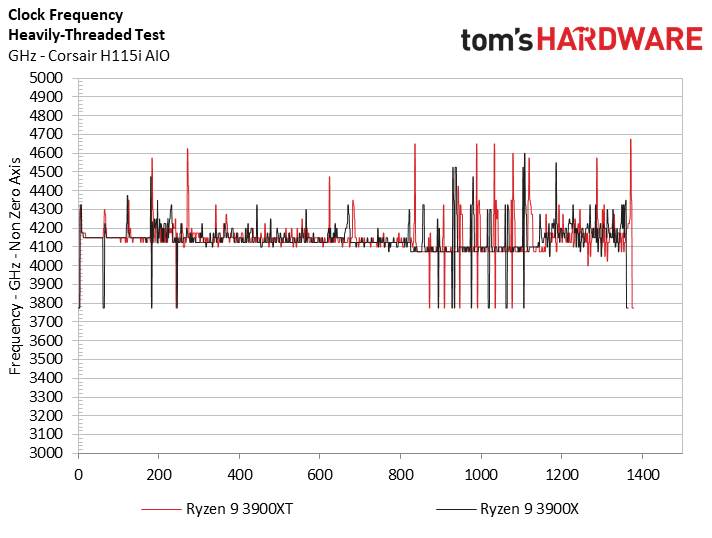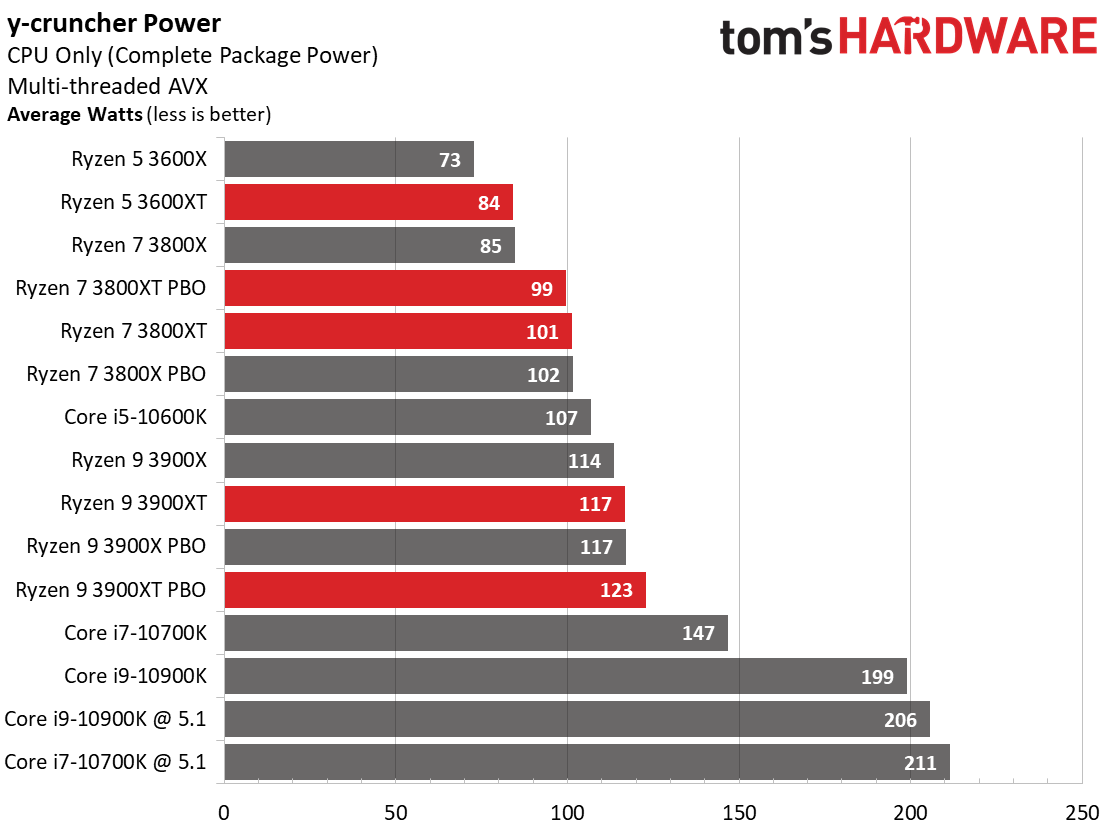Why you can trust Tom's Hardware
AMD Ryzen 9 3900XT Boost, Power and Thermals




We ran our standard frequency test for lightly-threaded workloads (methodology here). This lightly-threaded test regimen is designed to extract the highest boost clock rates possible as we step through five iterations of the LAME encoder, then single-threaded POV-Ray and Cinebench runs, PCMark 10, GeekBench, and finally the VRMark Orange Room test. To keep the charts 'clean,' we only plot the maximum frequency recorded on any one core during the test.
The first slide tells the story pretty clearly - the Ryzen 9 3900XT holds its boost clock of 4.7 GHz consistently throughout the first series of tests. The chip even exceeds the maximum rated 4.7 GHz clock rate and pegs the needle at 4.775 GHz for short bursts. That shows just how well the Precision Boost 2 algorithms can extract more performance from better cooling solutions, but we also have to keep in mind that silicon quality plays a role, so your mileage may vary.
In contrast, the Ryzen 7 3900X peaks at 4.65 GHz, and boost duration is both less frequent and of shorter duration. The voltage, power consumption, and temperature charts show that the 3900XT accomplished this feat with slightly lower voltages (silicon quality could weigh in here) and drew slightly more power during the test. Note that you can use these temperature measurements, and those in the following tests, as a measure of what to expect with Ryzen XT processors in both lightly- and heavily-threaded workloads.




We tested multi-core workloads with a string of real-world stress tests that include multiple instances of the Corona ray-tracing benchmark, x265 HandBrake rendering tests, POV-Ray multi-threaded benchmarks, Cinebench R20 runs, and finally five iterations of the AVX-intensive threaded y-cruncher.
Here we can see the 3900XT boost higher during some idle portions of the test, but both chips reach similar peak clocks during the heavily-threaded portions of the test. Here the Ryzen 9 3900XT is largely bumping against AMD's power limits, just like the 3900X, so it consumes a similar amount of power and generates a similar amount of heat. Performance is very similar in these heavily-threaded workloads, too.
We see a bit of a different picture with the Ryzen 7 3800XT below.
AMD Ryzen 7 3800XT Boost, Power and Thermals




The goal of the Ryzen 7 3800XT single-threaded tests is to kick the tires and see if the 200 MHz increase to the boost clock is real. It is – the chip exceeds its rated boost frequency and peaks at 5.75 GHz. Like the 3900XT, boost duration is longer, and the boosts happen more frequently, too.
Get Tom's Hardware's best news and in-depth reviews, straight to your inbox.
Again, the 3800XT runs at a slightly lower voltage than its X-series counterpart, but the increased power draw, especially during the opening stages of the benchmark, is more pronounced than the deltas we recorded between the 3900XT and 3900X. Of course, we're looking at the 3800XT's ~200 MHz clock rate increase as opposed to the 3900XT's ~100 MHz, so that's expected.
The 3800XT's increased clock rates over the 3800X also equates to higher heat output than the 3800X. That's acceptable, though, given the higher performance.




The Ryzen 7 3800X has four fewer cores than the Ryzen 9 3900XT, but it has the same power governor (PPT, EDC, EDT) limitations as the 3900XT. Due to the lower power consumption of its eight-core design, it has more available power consumption headroom before it trips the power limits, which provides more opportunities to boost performance.
As a result, the 3800XT hits higher clock rates and provides more performance than the 3800X during the tests, but it also has notably higher power draw and heat output. That's an acceptable tradeoff.
These results show that we should expect more uplift for the 3800XT over the 3800X in heavily-threaded applications than we'll see with the 3900XT over the 3900X. That's because the 3900XT's hefty core count, by default, chews through more of the available power budget, causing it to hit the socket power limits before it can provide more performance.
AMD Ryzen 9 3900XT Power Consumption and Efficiency







AMD's reviewer guide states that the Ryzen XT processors offer more performance within the same power thresholds, meaning they'll provide more performance before they hit the power limits. However, AMD doesn't claim the chips are more power efficient (more performance-per-watt), and our testing generally reflected the trend of more performance in tandem with a commensurate increase in overall power consumption.
At stock settings, we logged an average of 117W of power consumption for the Ryzen 9 3900XT during the AVX-intensive multi-threaded y-cruncher workload, which is 3W higher than the Ryzen 9 3900XT. That isn't surprising because this heavy workload causes the 3900XT to hit the power limits. We also logged similar deltas in the other applications we use to measure power consumption, all of which load the processors heavily.
Meanwhile, the Ryzen 7 3800X consumed 85W during the y-cruncher test, but the 3800XT jumped to 101W. That shows again that, due to its lower core count, the 3800X still has plenty of room to consume the extra available power budget before triggering power restrictions. We see a similar result during the x264 Handbrake test - the 3800XT consumes 11W more than the 3800X.
The Ryzen 5 3600XT is also free to consume more power within the power limits defined by its TDP rating, so it also pulls more juice at stock settings than the 3600X.
In terms of power efficiency, the renders-per-hour charts show that the XT models all produce fewer renders per watt of power consumption. That shows that the Ryzen 3000 processors are more efficient when they operate further down the voltage/frequency curve, much like we see with the company's Eco Mode. These are AVX-heavy workloads, though, so you could see less of a delta with different workloads.
Despite the increased power draw, the Ryzen processors still dominate the comparable Intel processors in power consumption and efficiency metrics.


Here, we take a slightly different look at power consumption by calculating the cumulative amount of energy required to perform an x264 and x265 HandBrake workload, respectively. We plot this 'task energy' value in Kilojoules on the left side of the chart.
These workloads are comprised of a fixed amount of work, so we can plot the task energy against the time required to finish the job (bottom axis), thus generating a really useful power chart. Bear in mind that faster compute times, and lower task energy requirements, are ideal. That means processors that fall the closest to the bottom left corner of the chart are best.
These charts reveal the relatively slim performance gains, and the slightly higher power draw that comes as a result, of the Ryzen 7 3800X and the Ryzen 5 3600XT. However, due to the ever-present power restrictions, we don't see much of a change for the 3900XT in these heavily threaded tests.
Still, the 7nm Ryzen 3000 processors continue to exhibit lower power draw and superior power efficiency compared to Intel's Core chips with the hyper-optimized 14nm process.
Test Setup and Ryzen 9 3900XT Overclocking
AMD says you shouldn't expect any extra manual overclocking headroom with the Ryzen XT processors, but we did notice slightly better performance from the auto-overclocking PBO feature with the XT chips. That comes largely as a benefit of the higher boost capabilities. Given the slightly lower voltages we've seen with our sample, it's logical to expect you may be able to attain similar manual overclock ceilings to the X-series processors, but at a slightly lower voltage.
We haven't had time to test manual overclocking with the XT series processors fully yet, and it would be impossible to make a definitive measure with a sample size of one processor. Especially given the vagaries of the silicon lottery. However, we don't expect explosive performance improvements from manual overclocking.
Overclocking headroom is extremely limited on the Ryzen 3000 processors, and exceeding the boost clocks, or even meeting them, typically isn't possible for all-core overclocking with conventional cooling. We stuck with AMD's auto-overclocking PBO feature as it offers improved multi-threaded performance while maintaining most of the single-threaded performance that comes from the default boosting mechanism. We tuned the memory in tandem with the PBO feature by using the XMP profile to enable DDR4-3600 with 16-16-16-36 timings.
| Intel Socket 1200 (Z490) | Core i7-10700K, Core i9-10900K, Core i5-10600K |
| Row 1 - Cell 0 | Gigabyte Aorus Z490 Master |
| Row 2 - Cell 0 | 2x 8GB G.Skill FlareX DDR4-3200 - Stock: DDR4-2933, OC: DDR4-3600 |
| AMD Socket AM4 (X570) | AMD Ryzen 9 3900XT, 3900X; Ryzen 7 3800XT, 3800X; Ryzen 5 3600XT, 3600X |
| MSI MEG X570 Godlike | |
| Row 5 - Cell 0 | 2x 8GB G.Skill FlareX DDR4-3200 - Stock: DDR4-3200, OC: DDR4-3600 |
| All Systems | Nvidia GeForce RTX 2080 Ti |
| 2TB Intel DC4510 SSD | |
| EVGA Supernova 1600 T2, 1600W | |
| Row 9 - Cell 0 | Open Benchtable |
| Windows 10 Pro (1903 - All Updates) | |
| Row 11 - Cell 0 | Workstation Tests - 4x 16GB Corsair Dominator - Corsair Force MP600 |
| Cooling | Corsair H115i, Custom loop |
MORE: Best CPUs
MORE: Intel and AMD Processor Hierarchy Comparisons
MORE: All CPUs Content
Current page: AMD Ryzen 9 3900XT Boost, Thermals, Overclocking, Power Consumption
Prev Page AMD's Ryzen XT Refresh Next Page AMD Ryzen 9 3900XT Gaming Benchmarks
Paul Alcorn is the Editor-in-Chief for Tom's Hardware US. He also writes news and reviews on CPUs, storage, and enterprise hardware.
-
jimmysmitty ReplyInvalidError said:AMD micro-binning the hell out of Zen 2.
I find it interesting yet expected. Both do this when they can. It also makes sense to remove the cooler, although Intel got hell for it, with a CPU thats designed for higher performance. Most people who build a system with top end CPUs tend to buy a third party cooler anyways and it just becomes more waste. -
King_V (sarcasm)Reply
AMD has been listening to the Intel fanboys on the forums. Higher clocks are all that matter. Included coolers are always stupid, because nobody will use them.
So, AMD offered just such an option. Ergo, having catered to what the Intel fanboys wanted, I obviously expect to see them snapping up Ryzen XT processers en-masse
(/sarcasm) -
InvalidError Reply
Part of that "hell" is for charging more despite removing the stock HSF which is in itself already an intrinsic value loss. If I'm going to get negative value for my money from ditching the stock HSF, I'll take the stock HSF even if I have no plan to actually use it.jimmysmitty said:It also makes sense to remove the cooler, although Intel got hell for it, with a CPU thats designed for higher performance. -
jimmysmitty ReplyInvalidError said:Part of that "hell" is for charging more despite removing the stock HSF which is in itself already an intrinsic value loss. If I'm going to get negative value for my money from ditching the stock HSF, I'll take the stock HSF even if I have no plan to actually use it.
They did the same thing here though.
But still the mass majority would throw the HSF away creating waste. Not worth it IMO. -
InvalidError Reply
You can flip the Prism on eBay for ~$35.jimmysmitty said:But still the mass majority would throw the HSF away creating waste. Not worth it IMO.